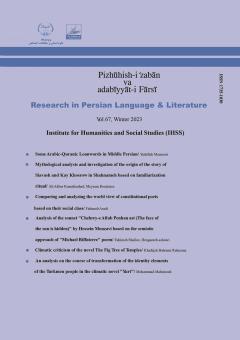Some Arabic-Quranic Loanwords in Middle Persian
Subject Areas : پژوهشهای ادبیات کلاسیک ایران
1 - Associate Professor, Department of Linguistics, Shahid Beheshti University, Iran.
Keywords: loanword, Quranic words, Arabic, Middle Persian. ,
Abstract :
Regarding Arabic loanwords in Farsi, the dominant view is that the arrival of Arabic words in the Islamic period, that is, after Islam came to Iran, was mostly in Persian in the sixth and seventh centuries and their presence in Persian texts is strong and intensified. In this research, we are trying to show, as far as the documents are available, that the introduction of Arabic words into Persian language happened a long time ago,And this cultural-linguistic exchange has probably taken place since the time when Iranians and Arabs have been in contact with each other, that is, since the Achaemenid period.
اقبال آشتياني، عباس (1389) تاريخ ايران، چاپ هفتم، تهران، نامك.
جفری، آرتور (1372 ) واژههای دخیل در قرآن مجید، ترجمه دکتر فریدون بدرهای، تهران، توس.
ژينيو، فليپ (1984) ارداويرافنامه (ارداويرازنامه)، ترجمه و تحقيق دكتر ژاله آموزگار ( 1372)، تهران، معين.
فرهوشي، بهرام (مترجم، 1378) كارنامة اردشير بابكان، تهران، دانشگاه تهران.
مزداپور، کتایون (مترجم، 1378) بررسي دستنويس م.
او29 (داستان گرشاسب، تهمورس و جمشید، گلشاه و متنهاي ديگر)، تهران، آگه.
میرزای ناظر، ابراهیم (مترجم، 1373) روزِ هرمزد ماهِ فروردین- ماهِ فروردین، روزِ خرداد (همراه با متن پارسی میانه)، مشهد، ترانه.
ماهیار نوابی، یحیی (مترجم، 1374) يادگار زريران، تهران، اساطير.
Anklesaria, B. (1949) Pahlavi Vendidâd (Zand-î Jvît-dêv-dât), Bombay.
Darmesteter, J., 1898, Vendidad or lows against the demons, Avesta, The Scared Books of Zoroastrianism, Book 3, (from Scared Books of the East) ed. by Joseph H. Peterson, 1995 (Avesta.org).
Durkin-Meistrerernst, Desmond (2004) Dictionary of Manichaean Middle Persian- and Parthian, School of Oriental and African Studies, University of London.
Jamasp-Asana H.D.J. & W. West (1887) Shikand-Gûmânîk Vijâr (The Pâzand-Sanskrit text together with a fragment of the Pahlavi), Bombay.
Kent, R. G. (1953) Old Persian (Grammar-Texts-Lexicon), New Haven.
de Menasce J. P. (1945) Škand-Gumānīk Vičār, Fribourg.
Nyberg, H. S. (1974) A Manual of Pahlavi, Vol. II, Wiesbaden.
Sanjana, D. D. Peshotan (1895) The Zand í Javít Shêda dâd, Vendidâd (The Pahlavi version of the Avesta), Bombay.
متون پهلوی با نشانههای اختصاری: AWN = Gignoux, Ph. (1984) Le Livre d’ Arda Virāz, Paris.
Az = Jamasp-Asana, J. D. J. (ed., 1897) Pahlavi Texts, Bombay.
DK5 = Amouzgar, J, et A. Tafazzoli (2000) Le Cionquiéme Livre du Dēnkard- (5), Paris.
KNA = Antia, E. K. (1900), Kârnâmak-i Artakhshîr Pâpakân, Bombay.
MGA = Chacha, H. F. (1936), Gajastak Abâlish (Mātīkān ī Gajastak Abālīš), Bombay.
MU29 = MS. MU 29, D. K. Jamasp Asa, M. Nawabi, B. Farahvashi (ed., 1976), The story of Garshasp, Tahmurath, Jamshid, and other texts, [with the technical assistance of M. Tavousi], Shiraz.
Pahl.Vd. = Jamasp, D. H. (1907) Vendidâd (Avesta text with Pahlavi translation and commentary, and glossarial index), vol. 1 (texts), Bombay.
SHE = Daryaee, T. (2002) Šahrestānīhā ī Ērānšahr (A Middle Persian Text on Late Antique Geography, Epic, and History), Colifornia.
ZXA = Dhabhar, E.B.N. (ed., 1927), Zand i Khūrtak Avistāk, Bombay.


